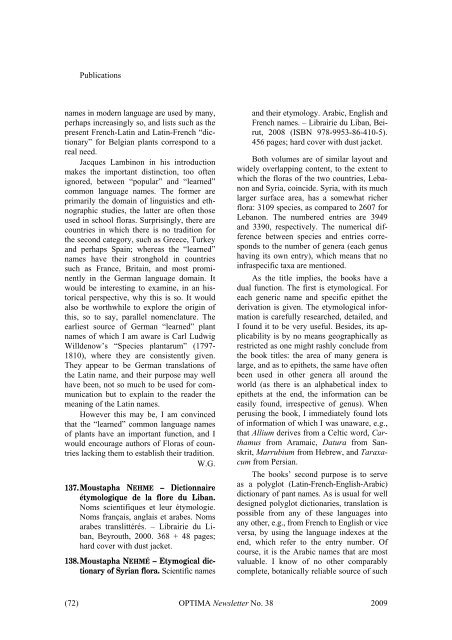OPTIMA Newsletter 38
OPTIMA Newsletter 38
OPTIMA Newsletter 38
You also want an ePaper? Increase the reach of your titles
YUMPU automatically turns print PDFs into web optimized ePapers that Google loves.
Publications<br />
names in modern language are used by many,<br />
perhaps increasingly so, and lists such as the<br />
present French-Latin and Latin-French “dictionary”<br />
for Belgian plants correspond to a<br />
real need.<br />
Jacques Lambinon in his introduction<br />
makes the important distinction, too often<br />
ignored, between “popular” and “learned”<br />
common language names. The former are<br />
primarily the domain of linguistics and ethnographic<br />
studies, the latter are often those<br />
used in school floras. Surprisingly, there are<br />
countries in which there is no tradition for<br />
the second category, such as Greece, Turkey<br />
and perhaps Spain; whereas the “learned”<br />
names have their stronghold in countries<br />
such as France, Britain, and most prominently<br />
in the German language domain. It<br />
would be interesting to examine, in an historical<br />
perspective, why this is so. It would<br />
also be worthwhile to explore the origin of<br />
this, so to say, parallel nomenclature. The<br />
earliest source of German “learned” plant<br />
names of which I am aware is Carl Ludwig<br />
Willdenow’s “Species plantarum” (1797-<br />
1810), where they are consistently given.<br />
They appear to be German translations of<br />
the Latin name, and their purpose may well<br />
have been, not so much to be used for communication<br />
but to explain to the reader the<br />
meaning of the Latin names.<br />
However this may be, I am convinced<br />
that the “learned” common language names<br />
of plants have an important function, and I<br />
would encourage authors of Floras of countries<br />
lacking them to establish their tradition.<br />
W.G.<br />
137. 136BMoustapha NEHME – Dictionnaire<br />
étymologique de la flore du Liban.<br />
Noms scientifiques et leur étymologie.<br />
Noms français, anglais et arabes. Noms<br />
arabes translittérés. – Librairie du Liban,<br />
Beyrouth, 2000. 368 + 48 pages;<br />
hard cover with dust jacket.<br />
1<strong>38</strong>. 137BMoustapha NEHMÉ – Etymogical dictionary<br />
of Syrian flora. Scientific names<br />
and their etymology. Arabic, English and<br />
French names. – Librairie du Liban, Beirut,<br />
2008 (ISBN 978-9953-86-410-5).<br />
456 pages; hard cover with dust jacket.<br />
Both volumes are of similar layout and<br />
widely overlapping content, to the extent to<br />
which the floras of the two countries, Lebanon<br />
and Syria, coincide. Syria, with its much<br />
larger surface area, has a somewhat richer<br />
flora: 3109 species, as compared to 2607 for<br />
Lebanon. The numbered entries are 3949<br />
and 3390, respectively. The numerical difference<br />
between species and entries corresponds<br />
to the number of genera (each genus<br />
having its own entry), which means that no<br />
infraspecific taxa are mentioned.<br />
As the title implies, the books have a<br />
dual function. The first is etymological. For<br />
each generic name and specific epithet the<br />
derivation is given. The etymological information<br />
is carefully researched, detailed, and<br />
I found it to be very useful. Besides, its applicability<br />
is by no means geographically as<br />
restricted as one might rashly conclude from<br />
the book titles: the area of many genera is<br />
large, and as to epithets, the same have often<br />
been used in other genera all around the<br />
world (as there is an alphabetical index to<br />
epithets at the end, the information can be<br />
easily found, irrespective of genus). When<br />
perusing the book, I immediately found lots<br />
of information of which I was unaware, e.g.,<br />
that Allium derives from a Celtic word, Carthamus<br />
from Aramaic, Datura from Sanskrit,<br />
Marrubium from Hebrew, and Taraxacum<br />
from Persian.<br />
The books’ second purpose is to serve<br />
as a polyglot (Latin-French-English-Arabic)<br />
dictionary of pant names. As is usual for well<br />
designed polyglot dictionaries, translation is<br />
possible from any of these languages into<br />
any other, e.g., from French to English or vice<br />
versa, by using the language indexes at the<br />
end, which refer to the entry number. Of<br />
course, it is the Arabic names that are most<br />
valuable. I know of no other comparably<br />
complete, botanically reliable source of such<br />
(72) <strong>OPTIMA</strong> <strong>Newsletter</strong> No. <strong>38</strong> 2009






